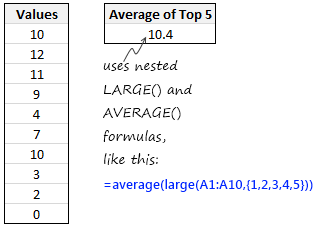The other day, while doing consulting for one of my customers, I had a strange problem. My customer has data for several KPIs and she wants to display average of top 5 values in the dashboard.
- Now, if she wants average of all values, we can use AVERAGE() formula
- if she wants top 5 values to be highlighted, we can use LARGE() formula and CF.
but average of top 5?
I said what any consultant would say. “It is possible”
After thinking for a while, I found the solution by nesting LARGE() formula with AVERAGE() formula. Like this:
=AVERAGE(LARGE(A1:A10,{1,2,3,4,5}))

There is no need to press CTRL+SHIFT+Enter after this formula and it works fine.
You can use similar formula to get Average of bottom 5 values like this:
=AVERAGE(SMALL(A1:A10,{1,2,3,4,5}))
Now, your home work:
Ok, here is an interesting twist to this formula. My formula works fine as long as the list has at least 5 values in it. But, lets say the input range (a1:a10) is dynamic. That means, it can grow or shrink.
Now, how would you modify this formula so that it works even when there are less than 5 values ?
Go, figure that out. When you are done, come back here and post a comment.




















One Response to “How to export YouTube video comments to Excel file? – Free template + Power Query case study”
And I asked myself when i saw your Accouncement Video for the Give away: "Seriously, will Chandoo go manualy thru all his Videos and pick the winners?!". Great connection to the give away with this tutorial 🙂 !